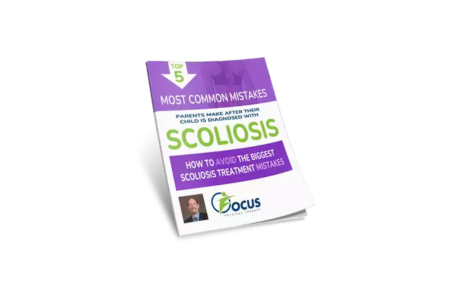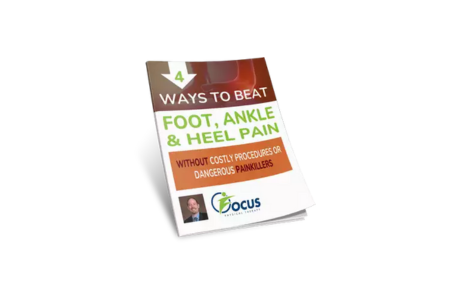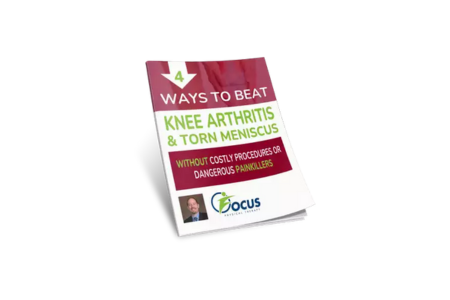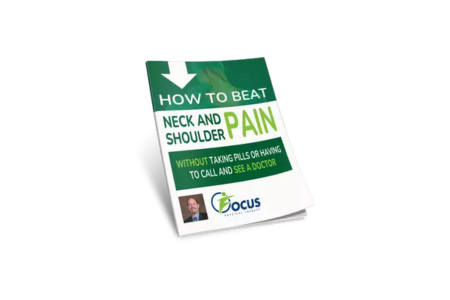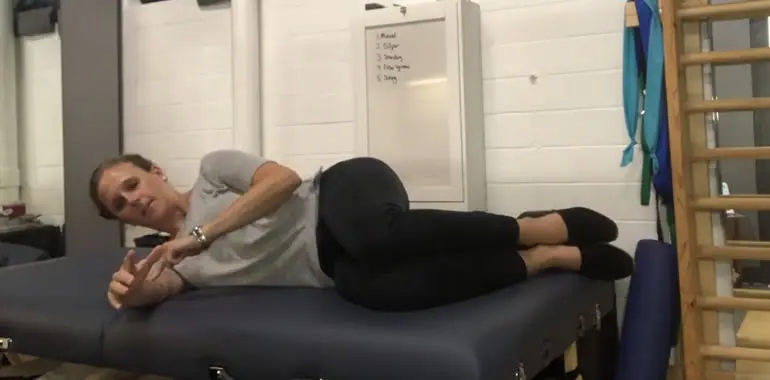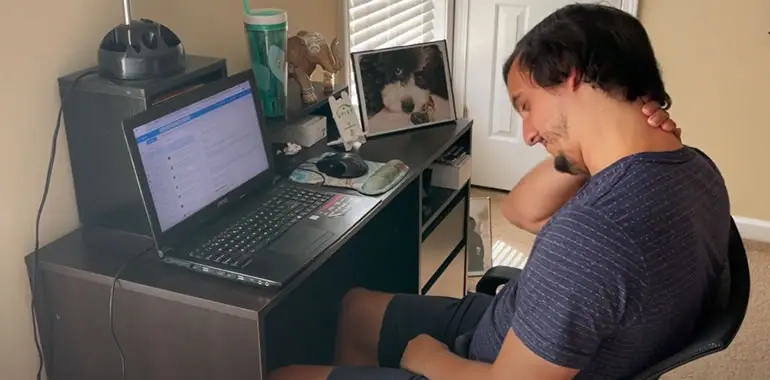Is Knee Pain Affecting Your Lifestyle?
- Dr Brad Conder

It might not be your knee that’s the problem. Your knee pain could indicate that you’ve got something else going on.
You’ve asked the question. Now we’ll tell you the answer.
Does Sciatica cause knee pain?
In short, yes. Yes, it can.
But how does that make any sense?
Let us explain.
It’s a common misconception that when you feel pain or discomfort in your knee, that the source must be from within the knee joint itself; or the surrounding tendons or ligaments. However, it might surprise you to learn that this may not be the case.
Oftentimes, the cause of your knee pain is located in your spinal cord, or within the nerves associated with your lower leg. That probably sounds unrealistic, but the spinal nerves link directly to your knee muscles.
Thus, if there’s excess force compressing these nerves inside your body (such as inflammation from injury), then your knee can become the reception point for pain on that ‘circuit’ of nerves. This can lead to various knee issues.

What Symptoms Should I Watch For?
There are a number of symptoms and indications to watch for that suggest your knee pain relates to issues with your spinal cord.
Alongside the knee pain that you are experiencing, there is a high chance of back pain. If you have simultaneous discomfort in your back and knee, it could mean that you have something compressing the nerves in your spine, or your sciatic nerves.
Hold up. What’s my sciatic nerve?
Your sciatic nerve branches down from your lower back, through your hips/buttocks, and then down each leg. You may have heard the term ‘Sciatica’ before, and that refers to pain that radiates along the network of sciatic nerves.
More on that in a bit.
So – feel some tightness in your lower back? If you remain largely inactive for long stretches of time and feel discomfort in your knees and back, chances are that the two things are connected.
That’s because remaining seated (at a desk, on the couch, or after very long journeys) compresses your spinal disks, extending their “bulge” in the process. Remaining sedentary puts an unhealthy strain on your disks compared to standing upright.
By putting stress on your disks, you affect the nerves that connect your lower back and knees. The pain created is channeled directly towards your knee should the excess pressure pinch a nerve and cause problems in the lumbar region.
Even if your pain is mild, we’d recommend booking a consultation with a physical therapist. They can provide a complete evaluation and create a bespoke package of care that gets you back to health.
Do you also feel tightness in your hamstrings (those large muscles behind your thighs)? Or perhaps you’ve noticed tension in your leg muscles after exercising lately. If stretching doesn’t seem to shift the tightness, then you may have another indication that the spinal nerves are causing your knee pain.

What’s happening here is, when these essential muscles become chronically tight, your lower back stability decreases. By losing strength here, you place stress on your spinal joints – as your lower back attempts to address the imbalance and adjust to your body’s changing form.
This imbalance paired with chronically-tight muscles creates a loss of stability, which generates lower back pain that carves a path down into the knees (and often the legs). If this sounds like you, and you struggle to move around without further damaging the hamstrings, you need to consult a physical therapist.
If you opt not to seek treatment for this pain, your hamstrings can eventually become swollen and lead to permanent damage.
The tightness in the muscle and connective tissue can erode the meniscus in your knee (A c-shaped piece of tough, rubbery cartilage that acts like a shock absorber between the shinbone and the thigh bone).
You may also feel a weakness in your hips/quadriceps; the frontal area of your thigh. For those of a bodybuilding persuasion, you’ll know these as ‘teardrops’, on account of how these muscles pop and appear (in a teardrop shape) under tension.
The quadriceps assist with movement in the hip and knee thanks to connective muscles and tissues attached to the ball-and-socket joint in your hip. Should there be any form of weakness (or dysfunction) in your quadriceps, then your hip will be affected, too.
Don’t forget – the entire body is connected. Nerves from the spine connect and control the quad and hip movements. If these nerves then become pinched or aggravated, you’ll have discomfort, pain, or weakness in your knee.
Then there are bunions to look out for. Yup, you read that correctly. It sounds very unusual to connect your spine with developing bunions – a bony bump that develops on the joints of your toe – but, individuals with spinal problems can develop bunions due to stability.
The spinal nerves link to the muscles in your feet, and should these nerves incur damage, then movement is impaired and cause your feet to turn inwards – flattening the arch of the foot.
The resulting inflammation causes a condition known as “foot pronation”, which describes the misalignment of the central tendon and the big toe’s unnatural inward curvature.
But what does this have to do with knee pain? Well, the changes in your walking pattern stem from your knee pain and the alignment of your hips and knees. The resulting pain can be profound.
Sciatica And Knee Pain

So, back to our original question.
Can sciatica cause knee pain?
Sciatica is officially defined as when there is an issue with your sciatic nerve that causes pain.
As we’ve said in the section above, the majority of knee pain cases are caused by issues with the nerves that connect the spine and lower parts of your body. And perhaps the most susceptible nerve to these issues remains the sciatic nerve – the longest and largest within the human body.
Stretching from your lower back and down to your toes, via the back of your knees, the sciatic nerve is interwoven with the muscles in your knees, which can send painful nerve impulses and masquerade as an issue with your knee. Even if your knee is perfectly innocent!
Injury and aging can play a part in this, too. As your spinal vertebral disks begin to bulge outwards through deterioration, your sciatic nerve becomes pressured; which causes pain that radiates from your lower back and downwards into your legs.
This pain will reach your knee if the nerve is pinched at the 2nd, 3rd, or 4th vertebra. “Referred Pain” is the term used to describe discomfort that originates in one part of the body but is felt elsewhere because of the connecting sensory nerves.

Sciatica: How You’ll Feel
Sciatica usually starts as a shooting pain in the lower back, which quickly spreads down your legs, towards your knee. You may also feel pain or discomfort in other parts of your body that seem unconnected, such as the outside edge of your leg, or down the side of your hip. You may feel all of this at the same time.
However, in the case of low-level sciatic nerve irritation, you might not even feel any pain in the lower back, the hip, leg, or knee. The damaged nerve will instead work ‘behind the scenes’ to weaken the muscles around your knee, which in turn leads to extreme discomfort.
You may also feel tingling, or numbness, in your legs and/or feet.
Root causes of sciatica include osteoarthritis, pregnancy, herniated disks, and degenerative disk disease. Although, there are other causes that you should know about. You can read about them here.

Sciatica: Getting A Diagnosis
If the cause of your sciatica can’t be determined by a physical therapist, or is not immediately apparent, then you’ll probably want to organize some tests with your doctor, or seek an X-ray to confirm a diagnosis and identify whether a problem with your sciatic nerve is the actual cause of your knee pain.
Once you’ve discovered the cause of the problem, our physical therapists can then create a bespoke treatment plan to combat the underlying cause and treat your knee pain in tandem.
Treatments for sciatica-related knee pain can include self-care, physical therapy, postural correction (helps balance your weight evenly and keep your spinal cord in proper alignment), and an exercise regime. Surgery is only used as a last resort.
We would only recommend self-care if the symptoms are mild. This would include ensuring that you get adequate exercise, stretch on a morning and afternoon cycle, and maintain healthy eating for a healthy weight.
These aspects help to reduce the pressure on your sciatic nerve. Back strengthening exercises are also a good way to keep sciatica-derived knee pain at bay, as is getting enough sleep as this helps to reduce the symptoms of both sciatica and knee pain.
Get in touch with us to discuss your best treatment plan. Physical therapy is one of the most effective therapies for treating sciatica-related knee pain.
The best part? We don’t generalize. Everyone is different, and unique. The treatment plan that works for most, may not work for you. That’s why we take the time to get to know you.
If your pain is debilitating, please seek help. Don’t suffer in silence.
"Tell Us Where It Hurts..."
And We’ll Send You Our Best Advice And Top Tips In One Special Report...
It’s FREE! Just Look Below And Find The One That Works Best For You...



